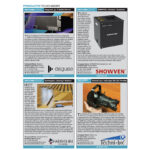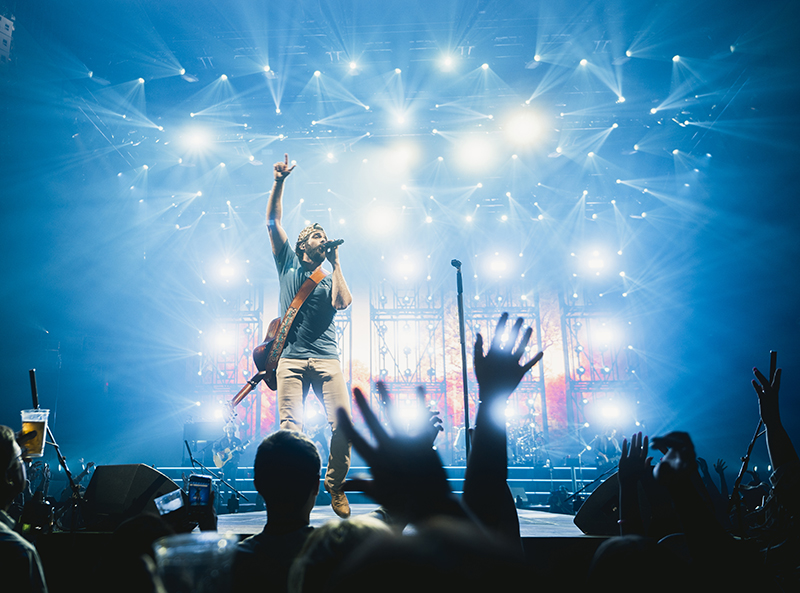
This past May, country superstar Thomas Rhett kicked off his Home Team Tour 23 and 40 cities later, wrapped up at the end of September. He has now notched 21 #1 songs on the charts and has a huge catalog to entertain his fans with when they flock to his dynamic live shows. Back for the tour providing production and lighting design was bkd Creative led by Alec Takahashi, who has been working with Thomas Rhett since 2018. In fact, at last year’s Parnelli Awards, Takahashi was honored with the newly named, Nook Schoenfeld Lighting Designer of the Year award for his work on Thomas Rhett’s 2022 tour. Recently, Takahashi took some time to speak with PLSN about the innovative production/lighting design of this year’s Home Team Tour 23.
The design process, a collaboration between Thomas Rhett and Takahashi, begins with some loose ideas. “He came to me last year and suggested, I should just design something crazy cool, and we would go from there,” says Takahashi. “So, I put together what I thought were cool elements, nice shapes, and then from there, we collaborate a lot back and forth. All the details and the overall design gets really fine-tuned and sharpened through the process working together.”
Layering in video was the next design step as Thomas Rhett wanted to put video content back into the show, “which we haven’t had in four or five years,” says Takahashi “He also wanted to put in more special effects, but everything needed to have intentionality. He wanted there to be purpose, not doing things just because we could do it, it had to be intentional. I admire his desire for everything to be purposeful; that there has to be a why. We need to know why we’re blowing up pyro, or why we’re playing this piece of video during this song. The meaning and careful placement of everything matters to me, and to him, as we are trying to put the story together.”

High Energy Show
Thomas Rhett puts on a very lively show, and he brings a lot of energy to his performance that his enthusiastic audiences really appreciate. “Finding those energy moments were very important to him and having that right dynamic,” comments Takahashi. “Even after opening night, more than halfway through the tour, we’ve still tried minimal tweaks of song placement. You play with that once you have an audience because when you’re rehearsing you have no gauge on the energy. You have no response, no crowd cheer. We really take the crowd feedback after the first few nights into consideration.”
There’s always a challenge with any concert to creating different looks over the course of the entire performance, but an artist like Thomas Rhett, who has such a range of work, makes it more important a focus. To help with that, Takahashi looked to automation to create different shapes and looks. “We knew early on that we wanted to incorporate some automated elements,” says the designer. “We played with the ideas of video pods, lighting pods, different ceilings, elements like that, really working to maximize the automated elements that made sense with the wider show design. We landed on a place where he was really happy and excited, I was really happy and excited, and we didn’t have to compromise any other elements. As everyone touring knows, that is a good place to end up with a design.”
That harmonious experience extends to the design elements as well in Takahashi’s production design. “We wanted to put this show together in a visual sense, where the scenery, the production has very different feels through it and things reveal throughout the show. I layered this show with a lot of production elements. The show starts off with these automated bits very low, which eliminates the need to use the back wall of lights that I had, and eliminates the need to use the even further upstage wall of video content at the beginning. There are so many production layers there, and we wanted to slowly peel back the layers of what we could have, so there were several large reveal moments with different, previously not seen elements. Then once everything was revealed, we play the dynamic of, ‘okay, we want this show to change musically, visually, all in sync’. So, creating those different really intimate vibes, low ceilings, 50% of the rig turned off. Then have those moments of full energy, where things are moving, things are flashing, the full thing is revealed.” Piecing that together was tricky, but Takahashi knew that the goal “was to have so many different pieces and making the show look very different throughout without having too many set changes,” he explains. “We were able to use the tools that we had, and the layers that we had, to really change all the layering, change the feel, change the energy, all within our control.”
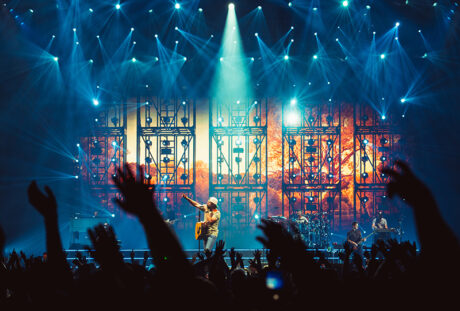
Layering Lighting and Video
One of the very interesting and successful design choices was Takahashi’s decision to put a wall of lights—Elation Dartz 360s—in front of a video wall made of highly transparent ROE Visual Vanish 8T LED video panels. It created an unexpected, and very effective look. “So, upstage video walls are common, they’re in a huge percentage of shows,” describes Takahashi, “and a lot of those video walls are made of blow-through video panels, like this one. However, we didn’t use it the same way, where a lot of people put production elements upstage of the video wall and shoot through the video. I’d never seen anyone do the opposite of that, and I really wanted to try that. It was a huge risk in my head, and I knew it would be a really interesting thing—and potentially controversial thing. And, I’ve found that my putting lights in front of a video wall has been a subject of discussion by others in the industry, with some people reaching out, asking ‘So, how’s that working?’ My answer is, I don’t think it’s for everyone, but I’m really pleased with what we pulled off with layering things in a way that hadn’t really been done before and doing it in a way that I think was beautifully placed. I wanted to just play with it and knew I never wanted to define the whole edge of the video wall.”
Takahashi continues, “When you have a lot of that negative space, when you have different masks, where you never see the hard edges of the actual wall, it leaves the brain to assume many things. You don’t know how big it is, you don’t know what shape it is. We can control the audience’s perspective on not knowing. There’s a big unknown aspect of that back there, so we played with that. There’s only one song in the whole show where there is a full screen of content, and you can see the full shape of it. Everything else really plays with the lighting layers in front, with the vertical pods that we had, where sometimes they’re masked to only show content behind the pods for layering, or only show content in between the pods.”
Takahashi was pleased with the result of how much layering and depth they could achieve putting the video wall upstage. “It also helped that a lot of the content was never faces or people, never video that you needed to watch per se. If that content was there, you would then be pretty annoyed that there’s stuff blocking the video wall, but we avoided that problem. We really played with secondary visuals, supporting visuals, textures, layering, where it was really nice and not annoying that you have to look through other production elements to see the content, it was just beautifully layered. Again, we knew that we wanted it to be intentional, and we knew we didn’t want it to be used in every single song.” The content for the tour was created by Nashville-based Andy Reuter. The media servers used on this production were from Green Hippo—two Hippotizer Boreal+, and one Hippotizer Karst+.

Gear Choices
For gear, Thomas Rhett has been a client of Upstaging since before Takahashi joined the production team. Upstaging’s Account Rep is John Bahnick, who works closely with the designer on what’s available in terms of gear. “When we start designing the show, I get a list of available inventory from John,” explains Takahashi. “If there’s something cool and groundbreaking that’s been released, then I’ll have the conversation asking if they’d think about investing in these products. All the video panels this year were brand-new out of the box that were brought with us, so that was the new element this tour. And I was really pleased with the ROE Vanish panel.”
Lighting-wise, the designer knew he wanted a large quantity of small fixtures on the upstage wall, and in the ceiling, to be a centerpiece. “I tried out the Elation Dartz from ‘21 to ‘22 and was really pleased with the output, the versatility, and the frost function. I knew I could get a huge variety of looks out of that fixture, especially in a large quantity. Upstaging has a huge quantity of Elation Dartz—we ended up with over 200, so it was a workhorse on this tour and the primary fixture in our production. The looks that we got out of it were phenomenal. From the tight beam moving around, crazy rock and roll looks to some nice soft looks for ballads; the very different shapes we could get, as we had a grid of them, was really strong.”
Takahashi is a big believer in having the least amount of different fixture types possible. “I don’t think you need a ton of different fixtures to have a great show, and it just complicates the cloning process for other shows. Sometimes you’ll need very specific fixtures to do very specific things. In this case, I only needed four fixture types. I had a spot, a strobe, a key light, and the Elation Dartz; that was it. It challenges you as a designer to use those spots sometimes as washes, which I’m a big believer in also. You don’t have to have it be a hard edge the whole time, you don’t have to have it a beam the whole time. These fixtures now have so many different capabilities, so I like using them to their full ability.”

His spot fixture of choice was the ACME Solar Impulse. “Upstaging has a large inventory of ACME fixtures,” states Takahashi. “I was skeptical at first, a couple years ago, to use them, but I have to say that I have minimal to no complaints. I think the weakness of it would be its color mixing, it is a little uneven in the pastel range, but for what we do on a Thomas Rhett show, it works beautifully. I think the color spectrum of those fixtures are pretty incredible for that. I don’t use them for key light lighting people, but as a primary spot fixture, a huge strong workhorse, it’s very bright, very beautiful. Just a really nice sharp zoom range and frost as well, so I can get some great, big wash looks out of it, as well as the beam gobo looks.”
The key light choice was the Ayrton Domino, of which he had eight, all on the Follow-Me Track-iT system to track Thomas Rhett and fellow mobile band members. “Those fixtures are phenomenal. As face light, I think their color mixing and color correction is really, really tight and clean. It produces a great quality of light to light subjects for camera, and for in-person. The throw on them was beautiful, nothing to complain about there.” Takahashi has worked with the Follow-Me system on Thomas Rhett’s tours since his first year out in 2018. He notes, “It started with the human operated Follow-Me system, and it always tracked Thomas for the past few years. It’s been excellent, and Follow-Me has been wonderful at helping with some of the challenges that we’ve faced over the years of pushing the limits of the system. This year we introduced the human-less system, so everyone had tags attached to them, and I’ve been very, very pleased with it. The make or break experience with Follow-Me is the technician that comes along with it, and ours is amazing. Skyler Dickenson, my Follow-Me Technician, handled all the Follow-Me stuff and was on top of any quirk. I was really pleased with the night-to-night tracking of everything.”
Continuing discussing his lighting choice, Takahashi says, “We had our Solaris Flares, which I think are one of my favorite fixtures ever made. No matter what color I choose, the intensity is there, and I can get some really nice pops and bangs out of those. That fixture, I think, is irreplaceable by any other strobe fixture out there on the market. I can get the really nice strobe quality and the punch out of them; they are a go-to for me.” Then, to add a color changing pop to his scenic risers, Takahashi went with the Edgelight RGB product from Nashville-based Go Live Productions. “They’re a local company here that makes custom LED products we lined all our risers with. That provided a nice baseline for the scenic elements. I was very happy with that choice.”
In terms of pyrotechnics and confetti special effects for the show, they were provided, along with the SFX crew from PyrotecnicoFX. “I worked with Rocco Vitale from Pyrotecnico on the timing, color choices, moments, and songs that we wanted,” recalls Takahashi, “then they created some cues, and we went back and forth on creating the looks that we ended up with in the show. It was good working with them.”
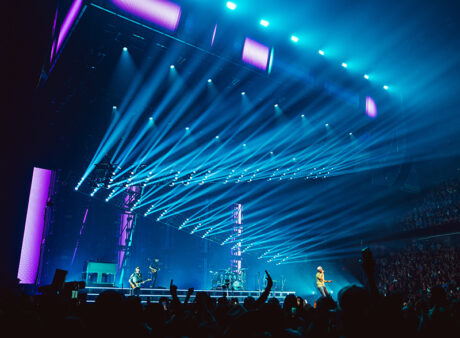
Vendor Support
For the Home Team Tour 23 Upstaging provided both the lighting and the video products. “Upstaging was fantastic,” states Takahashi, “and I know that Upstaging doesn’t provide video for a lot of tours, but they did a great job for us, including providing our full camera package, switchers, and media servers in addition to the LED video panels. Both the video and lighting support from Upstaging has been great. I am very pleased with it. Their support, sending out fixtures, dealing with maintenance, or any issues that we have, they’re on top of it. And they provide all my crew. My Lighting Crew Chief, Kile McClure, was my automation guy and has been with me for a few years now. He and I know each other—and our work styles—very well. He knows what I’m looking for day-to-day—in my perfectionist mind—on how things should be, so he really supports me in that way. Also, the Video Crew Chief—Ricky Krohne—has been the same since I started; he’s been phenomenal.” In fact, the crew on the tour has been a solid core for a few years now. “I’m very thankful that they desire to return to our show,” says Takahashi. “I have nothing to complain about in terms of Upstaging’s quality of support, the gear, or their people.”
The staging and automation vendor for this tour was TAIT, with TAIT’s Aaron Siebert as the Account Rep. “TAIT has also given us great support,” comments Takahashi. “I mean, we’re obviously one of their smaller clients, but they take us seriously, and they take care of us very well. We’ve used various staging from them over the years, decking, band riser packages, lifts here and there, and their support has been excellent. Obviously, they have some of the best staging out there, so it’s great to be working with them.”

Bringing it All Together
It’s hard to pin designers down to picking their favorite song, or moment, from a show, but Takahashi has a couple of songs that are favorites from a production standpoint. “I think my favorite song of the night was a song that just hit number one in the past couple months, called “Angels.” It’s a song he wrote about his wife, and our content creator, Andy Reuter, created this gorgeous sunset content that had paint splashes on it. There’s just such a beautiful feel to it. I blend lighting with that content. It’s beautiful layers, and I arced the lights around what the video was doing. Then there were some really drastic color changes for the bridge. Most of the lighting rig was off during this whole song, and I just thought musically and visually, that this was a showcasing moment of songwriting and visual art. Another one I loved, is on the opposite end of the spectrum, a song called “Craving You”. That showcased the firepower that we had, literally. Everything from video, pyro, lighting was all very carefully placed, intentional and timed out. It was such a captivating moment with everything in sync. Your senses just being—not necessarily overloaded—but you’re in a bit of a state of awe. There’s a lot going on, but everything’s happening purposefully and it all really worked together with the performance.”
It’s quite apparent that Thomas Rhett’s music—and his high energy performance—are well suited to the production and lighting design that bkd Creative’s Takahashi brings to support the tour. As musician, Thomas Rhett has a deep and a palpable connection to his audience. Takahashi and the production team all connect with the music as well and help bring it all together visually.
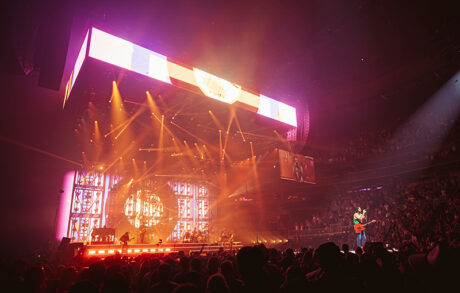
PRODUCTION TEAM
- Tour Managers: Jon Townley, Kamron Kimbro
- Production Manager: Kevin Twist
- Creative Direction: bkd Creative
- Production and Lighting Design: bkd Creative – Alec Takahashi and Benji Treuil
- Drafting Artist: Dave Carr
- Lighting Programmer/Lighting Director: Alec Takahashi
- Lighting Crew Chief: Kile McClure
- Lighting Crew: Aaron Walchli, Tony Quinn, Ryder Deas, Skyler Dickenson, Jesse Collins
- Follow Me Technician: Skyler Dickenson
- Video Director: Rob McLaughlin
- Video Engineer: Nick West
- Hippo Programmer: AJ DiCarlo
- Content Creation: Andy Reuter
- Video Crew Chief: Ricky Krohne
- Video Crew: Anthony Morgan, Nick Schlosser, Russ Spann, Brandon Fields
- Lead Rigger: Joanna Kiriacopoulos
- Rigger: Ryan Schilling
- Set Carps: Anthony Wilford, Andre Wilford, Michael Wise
- Pyro Tech: Christine Bernat
- Stage Manager: Justin Sumrall
VENDORS
- Lighting and Video: Upstaging, John Bahnick
- Staging and Automation: TAIT, Aaron Siebert
- Pyro: PyrotecnicoFX, Rocco Vitale
GEAR
Lighting
- 225 Elation Dartz 360 LED Beam
- 76 ACME Solar Impulse
- 8 Ayrton Domino Profile
- 65 TMB Solaris Flare Strobe
- 132’ Go Live Productions Edgelight RGB LED Tape
- 1 Follow-Me Track iT System
- 2 grandMA3 full-size
- 3 grandMA3 NPUs
- 5 grandMA2 8 port nodes
- 1 Lot Luminex Switches and Nodes
- 2 Brainstorm SR-112 SMPTE Distripalyzer
- 4 72-Way Lex 208V AC Rack
Video
- 180 ROE Visual Vanish V8T LED Video Panel
- 2 Green Hippo Hippotizer Boreal+ Media Server
- 1 Green Hippo Hippotizer Karst+ Media Server
Automation
- 1 Kinesys Vector Motion Control System
- 16 TourLift and Kinesys Elevation 2-Ton Hoist
Special Effects
- 1 Pyrodigital FC-A Field Controller
- 1 Pyrodigital FM-A Firing Module System


